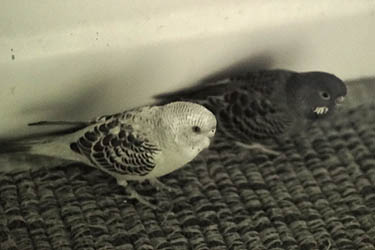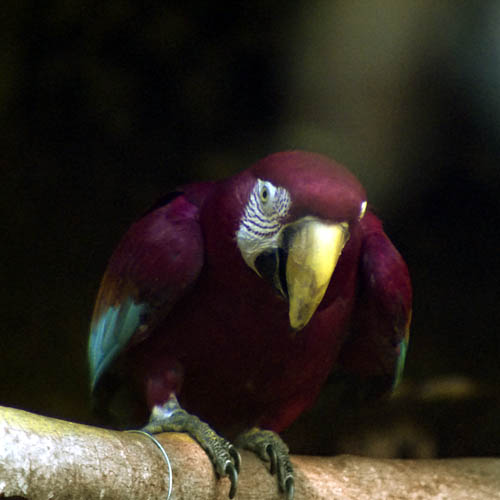Ultraviolet Bird Photography by Nathan Chronister
Aviary Species
These birds were photographed at the Buffalo Zoo. These environments make it possible to photograph a variety of colorful bird species from around the world, with the potential of finding some unique ultraviolet coloration or markings.
 visible light photo |
|
|
 ultraviolet photo |
Parrots can see ultraviolet light, and many of the species are very colorful. We might expect some of the parrots to have coloration extending into the ultraviolet part of the spectrum. The green-winged macaw is a great example. The blue feathers on the wings also reflect strongly in the ultraviolet. That gives them a blue-green color in the combined photo. The white face mask reflects throughout the visible and UV spectrum, so it appears white in all photos. The beak, however, does not reflect quite as much UV. To humans, the beak appears almost as white as the face, but to birds it would be seen as a different color. The same is true for the eyes.
 ultraviolet photo of parakeets |
Even the common parakeet or budgie has some interesting UV coloration. In fact, this is the only bird I know of that has a specifically ultraviolet-colored marking. Many birds have blue feathers that also reflect ultraviolet. But the budgie has a small patch on its chin that reflects mainly ultraviolet light. In this UV photo of parakeets, you can see the chin marking as a bright spot. To the human eye, it appears violet and is much darker than the surrounding feathers because of overall low visible light reflectance. The bird on the left is blue to our eye and reflects ultraviolet everywhere except the black spots on the wings. Notice the yellow and green budgie on the right is much darker in UV. This is different from other yellow birds, like the meadowlark, which reflect a good bit of ultraviolet. I believe this indicates a different pigment is being used in the budgies. |
 |
Just like the white paint on the neighboring structure, the beak of this spoonbill absorbs ultraviolet light. That causes it to appear yellow in the combined UV and visible light image. Interestingly, the UV absorptive area even extends onto the forehead, where there is a covering of feathers. Since the spoonbill may be among those birds that can't see ultraviolet light, it's possible this feature has something to do with protection from the sun, rather than making an impression on other spoonbills. |
 |
The scarlet ibis is even more stunning in this combined UV and visible light photo. Like the northern cardinal, it reflects primarily red and ultraviolet light. Not much blue or green. Red flowers, on the other hand, come in two varieties. Some reflect ultraviolet, while others do not. |
Ultraviolet Photo Galleries
